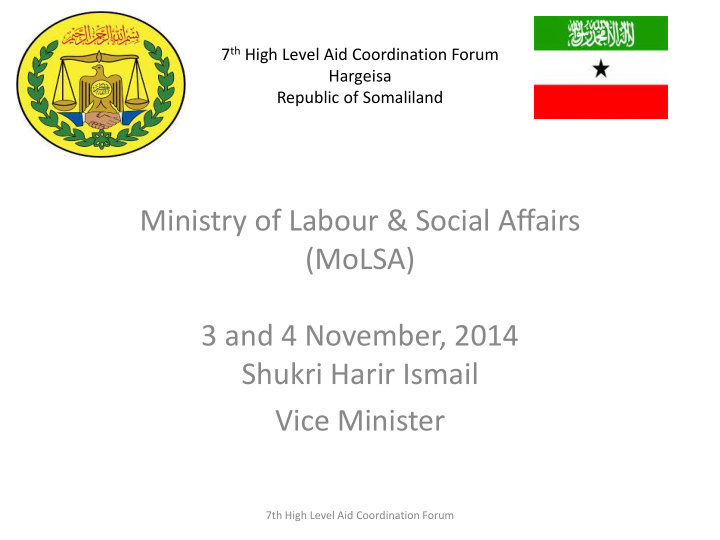



7 th High Level Aid Coordination Forum Hargeisa Republic of Somaliland Ministry of Labour & Social Affairs (MoLSA) 3 and 4 November, 2014 Shukri Harir Ismail Vice Minister 7th High Level Aid Coordination Forum
achievements • National Gender Policy in 2009. • National Gender Action Plan, 2013. • National FGM policy, although it is yet to be approved by the cabinet ministers. • National Disability Policy (Final) • National Plan of Action for Children (NPAC) in Somaliland, 2014 • Draft national child act, 2014
Some achievements continue--- • Creation of child and women desks at some police stations • Female prosecutors • Creation of Baahikoob/Waapo GBV shelters • GBV working group and coordination meetings. • Gender focal points & Inter-agency gender coordination mechanism • Capacity building support for women in politics.
Progress in education from gender perspective Primary students disaggregated by gender 2012/2013 Girls Boys 44% 56% Primary students Male 119,453 Female 95,578 Total 215,031
Progress in education continues--- Primary school teachers disaggregated by gender 2012/2013 19% Male Teachers Female Teachers 81% Primary teachers Male 5905 Female 1393 Total 7298
Progress in education continues--- Non-formal Education Secondary students. 2012/2013 2012/2013 Boys Boys Girls 36% 69% 31% Girls 64% Secondary NFE students Male 11380 Male 26,932 Female 20473 Female 12,306 Total 31853 Total 39,238
Progress in education continues--- University graduates 2012/2013 Technical Vocational Education 48% 38% Male Male Female Female 52% 62% Technical V. training University Male 1246 graduates Female 1376 Male 3256 Total 2,622 Female 2000 Total 5256
Women’s representations • The number of female councilors has comparatively increased from two women councilors in 2002 elections to 10 female councilors in 2012 District elections out of 345 councilors. Additionally, the number of women in the cabinet ministers increased from 1 in 2010 to 4 female ministers over the last years. • However, there is only one female MP In the parliament out of 164 MPs (House of Representatives and House of Elders). • Female Prosecutors appointed by the President. • Head of Somaliland Human Rights Commission. • President’s advisor on gender issues. • Newly appointed female member in electoral commission.
Candidates Gender disaggregated 7.6% Gender Number Percentag e (%) Male 2088 92.4 92.4 Female 172 7.6 Male % Total 2260 100% Percentage of elected female councilors Female 3% Aspirants politicians are Fewer Male less than outnumbered nominated by parties Female by male men politicians 97%
Gender Based Violence 1. FGM is the predominant form of GBV in Somaliland. Its prevalence rate is estimated over 90% 2. Rape has been on the increase over the past years as evidenced by following chart (Source: Baahikoob statistics and WAAPO) 350 290 300 250 195 200 142 150 130 105 100 50 0 2010 2011 2012 2013 First 6 months, 2014
Challenges • Involvement of traditional leaders in solving GBV, problems gives more chances to perpetrators to escape from the formal legal system. • Discriminatory traditions against women in politics. • Preferential treatment is given to boys in education. • Gender disparity in primary, secondary and tertiary education. • Inadequate qualified female teachers ( Role models) • Women do not have equal control and access to resources at all levels. ( Household to national levels)
Way forward • Engendering SDF and SSA. Alongside mainstreaming, specific measures targeting women should be developed. • Implementation of National Gender Action plan. • All forms of violence against women to be prevented and response adequately.( Rape, domestic violence, FGM etc) • Enhancing women’s access to Justice ( Public awareness raising, capacity building for law enforcing agencies on women’s rights, legal aid provision, advocacy for women’s representation in judiciary, law reform etc) • Promotion of women’s participation in decision making and politics ( elected bodies, civil service and political parties etc) Introduction of a quota system in electoral laws. • Gender mainstreaming: Building the capacity of gender machineries (Inter- agency gender coordination mechanism, Focal points, MoLSA and CSOs) • Increasing number of girls accessing education at all levels. • Public awareness raising on importance of girl child education. • Increase the number of female teachers. • Capacity building and Economic empowerment for economically impoverished women ( marketable skills, micro-credit schemes, institutional building for women groups, etc). • women’s Enhancing equal employment opportunities and eliminating discriminatory practices in employment and promotion in private and public sectors ( engendering and enforcing labor and civil service laws etc).
Recommend
More recommend